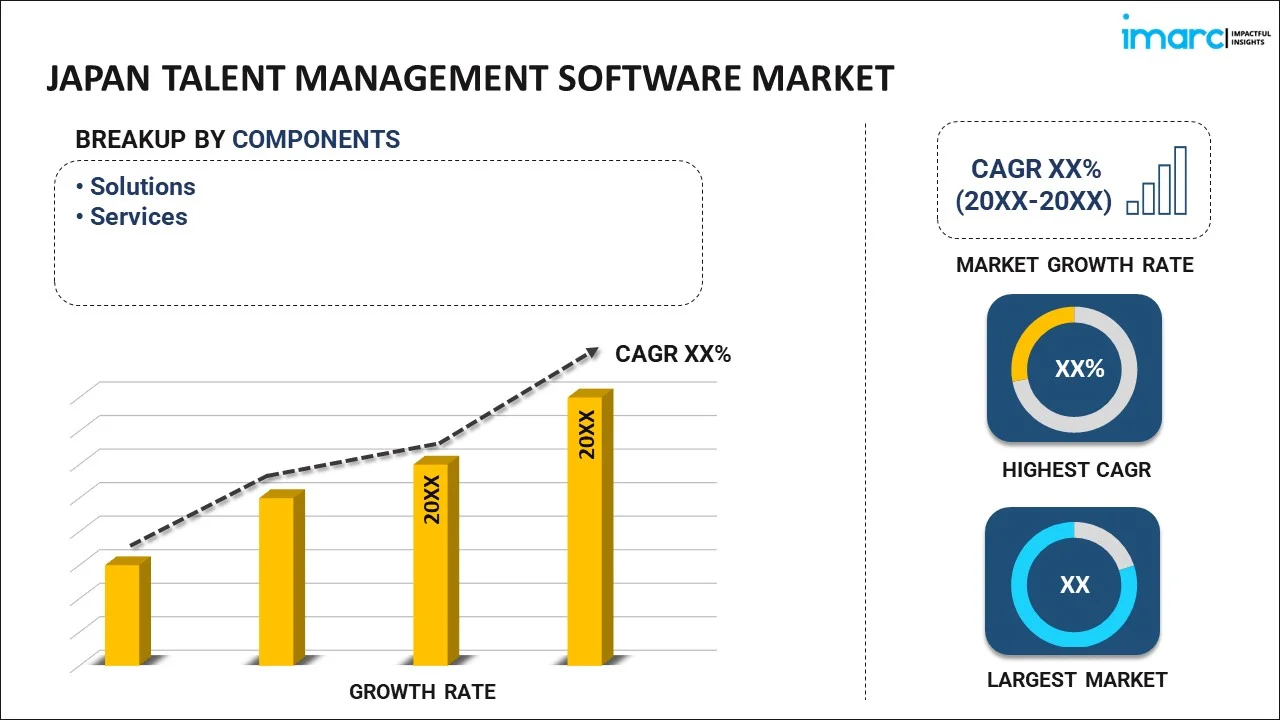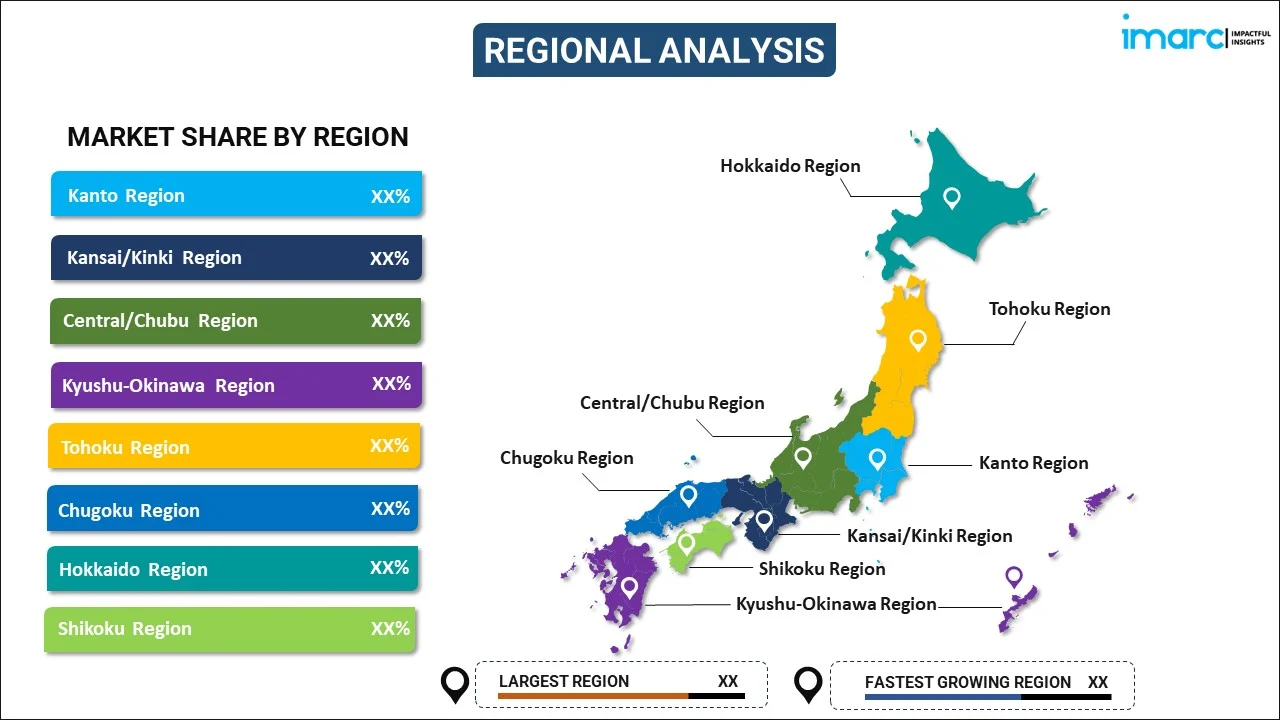
Japan Talent Management Software Market Report by Component (Solutions, Services), Deployment Type (On-premises, Cloud-based), Enterprise Size (Small and Medium-sized Enterprises, Large Enterprises), Vertical (BFSI, Healthcare, IT and Telecom, Retail, Manufacturing, Education, Government, Media and Entertainment, and Others), and Region 2025-2033
Market Overview:
Japan talent management software market size reached USD 761.4 Million in 2024. Looking forward, IMARC Group expects the market to reach USD 2,215.4 Million by 2033, exhibiting a growth rate (CAGR) of 11.4% during 2025-2033. The growing prevalence of digital transformation, along with the increasing need to replace manual HR processes with automated solutions, is primarily driving the market.
|
Report Attribute
|
Key Statistics
|
|---|---|
|
Base Year
|
2024 |
|
Forecast Years
|
2025-2033
|
|
Historical Years
|
2019-2024
|
| Market Size in 2024 | USD 761.4 Million |
| Market Forecast in 2033 | USD 2,215.4 Million |
| Market Growth Rate (2025-2033) | 11.4% |
Talent management software (TMS) is a comprehensive human resources technology solution designed to streamline and optimize the various aspects of talent acquisition, development, and retention within an organization. It encompasses a range of functionalities, including recruitment, performance management, learning and development, compensation planning, and succession planning. TMS is designed to centralize HR processes, making it easier for HR professionals to attract, nurture, and retain top talent. Key features of TMS typically include applicant tracking systems (ATS) for efficient recruitment, performance appraisal tools for assessing employee performance, learning management systems (LMS) for employee training and development, and tools for talent analytics to provide data-driven insights for decision-making. This software helps organizations identify and nurture high-potential employees, align individual goals with company objectives, and ultimately enhance overall workforce productivity. TMS can significantly improve HR efficiency, reduce administrative burdens, enhance employee engagement, and contribute to better talent decision-making, ultimately helping organizations achieve their strategic goals more effectively.
Japan Talent Management Software Market Trends:
The talent management software market in Japan is driven by several key factors. Firstly, the increasing need for organizations to effectively manage their human capital is a pivotal driver. As businesses recognize the critical role talent plays in achieving success, they are turning to software solutions to streamline recruitment, performance evaluation, and employee development. Additionally, the regional shift toward remote and hybrid work arrangements has accelerated the demand for talent management software. This trend necessitates robust tools for virtual onboarding, skills assessment, and performance monitoring. Furthermore, the growing emphasis on data-driven decision-making is propelling the market forward. Talent management software offers data analytics capabilities that enable companies to gain valuable insights into their workforce, helping them make informed talent-related decisions. Moreover, the competitive job market and the war for talent are compelling organizations to adopt sophisticated software to attract, engage, and retain top performers. In conclusion, the talent management software market in Japan is expected to be driven by the increasing recognition of talent's strategic importance, the evolving work landscape, and the demand for data-driven HR solutions.
Japan Talent Management Software Market Segmentation:
IMARC Group provides an analysis of the key trends in each segment of the market, along with forecasts at the country level for 2025-2033. Our report has categorized the market based on component, deployment type, enterprise size, and vertical.
Component Insights:

- Solutions
- Workforce Planning
- Learning Management
- Compensation Management
- Talent Acquisition
- Performance Management
- Services
- Professional Services
- Training and Education
- Support and Maintenance
The report has provided a detailed breakup and analysis of the market based on the component. This includes solutions (workforce planning, learning management, compensation management, talent acquisition, and performance management) and services (professional services, training and education, and support and maintenance).
Deployment Type Insights:
- On-premises
- Cloud-based
A detailed breakup and analysis of the market based on the deployment type have also been provided in the report. This includes on-premises and cloud-based.
Enterprise Size Insights:
- Small and Medium-sized Enterprises
- Large Enterprises
The report has provided a detailed breakup and analysis of the market based on the enterprise size. This includes small and medium-sized enterprises and large enterprises.
Vertical Insights:
- BFSI
- Healthcare
- IT and Telecom
- Retail
- Manufacturing
- Education
- Government
- Media and Entertainment
- Others
A detailed breakup and analysis of the market based on the vertical have also been provided in the report. This includes BFSI, healthcare, IT and telecom, retail, manufacturing, education, government, media and entertainment, and others.
Regional Insights:

- Kanto Region
- Kansai/Kinki Region
- Central/ Chubu Region
- Kyushu-Okinawa Region
- Tohoku Region
- Chugoku Region
- Hokkaido Region
- Shikoku Region
The report has also provided a comprehensive analysis of all the major regional markets, which include Kanto Region, Kansai/Kinki Region, Central/ Chubu Region, Kyushu-Okinawa Region, Tohoku Region, Chugoku Region, Hokkaido Region, and Shikoku Region.
Competitive Landscape:
The market research report has also provided a comprehensive analysis of the competitive landscape. Competitive analysis such as market structure, key player positioning, top winning strategies, competitive dashboard, and company evaluation quadrant has been covered in the report. Also, detailed profiles of all major companies have been provided.
Japan Talent Management Software Market Report Coverage:
| Report Features | Details |
|---|---|
| Base Year of the Analysis | 2024 |
| Historical Period | 2019-2024 |
| Forecast Period | 2025-2033 |
| Units | Million USD |
| Scope of the Report | Exploration of Historical and Forecast Trends, Industry Catalysts and Challenges, Segment-Wise Historical and Predictive Market Assessment:
|
| Components Covered |
|
| Deployment Types Covered | On-premises, Cloud-based |
| Enterprise Sizes Covered | Small and Medium-sized Enterprises, Large Enterprises |
| Verticals Covered | BFSI, Healthcare, IT And Telecom, Retail, Manufacturing, Education, Government, Media and Entertainment, Others |
| Regions Covered | Kanto Region, Kansai/Kinki Region, Central/ Chubu Region, Kyushu-Okinawa Region, Tohoku Region, Chugoku Region, Hokkaido Region, Shikoku Region |
| Customization Scope | 10% Free Customization |
| Post-Sale Analyst Support | 10-12 Weeks |
| Delivery Format | PDF and Excel through Email (We can also provide the editable version of the report in PPT/Word format on special request) |
Key Questions Answered in This Report:
- How has the Japan talent management software market performed so far and how will it perform in the coming years?
- What has been the impact of COVID-19 on the Japan talent management software market?
- What is the breakup of the Japan talent management software market on the basis of component?
- What is the breakup of the Japan talent management software market on the basis of deployment type?
- What is the breakup of the Japan talent management software market on the basis of enterprise size?
- What is the breakup of the Japan talent management software market on the basis of vertical?
- What are the various stages in the value chain of the Japan talent management software market?
- What are the key driving factors and challenges in the Japan talent management software?
- What is the structure of the Japan talent management software market and who are the key players?
- What is the degree of competition in the Japan talent management software market?
Key Benefits for Stakeholders:
- IMARC’s industry report offers a comprehensive quantitative analysis of various market segments, historical and current market trends, market forecasts, and dynamics of the Japan talent management software market from 2019-2033.
- The research report provides the latest information on the market drivers, challenges, and opportunities in the Japan talent management software market.
- Porter's five forces analysis assist stakeholders in assessing the impact of new entrants, competitive rivalry, supplier power, buyer power, and the threat of substitution. It helps stakeholders to analyze the level of competition within the Japan talent management software industry and its attractiveness.
- Competitive landscape allows stakeholders to understand their competitive environment and provides an insight into the current positions of key players in the market.
Need more help?
- Speak to our experienced analysts for insights on the current market scenarios.
- Include additional segments and countries to customize the report as per your requirement.
- Gain an unparalleled competitive advantage in your domain by understanding how to utilize the report and positively impacting your operations and revenue.
- For further assistance, please connect with our analysts.
 Inquire Before Buying
Inquire Before Buying
 Speak to an Analyst
Speak to an Analyst
 Request Brochure
Request Brochure
 Request Customization
Request Customization




.webp)




.webp)












